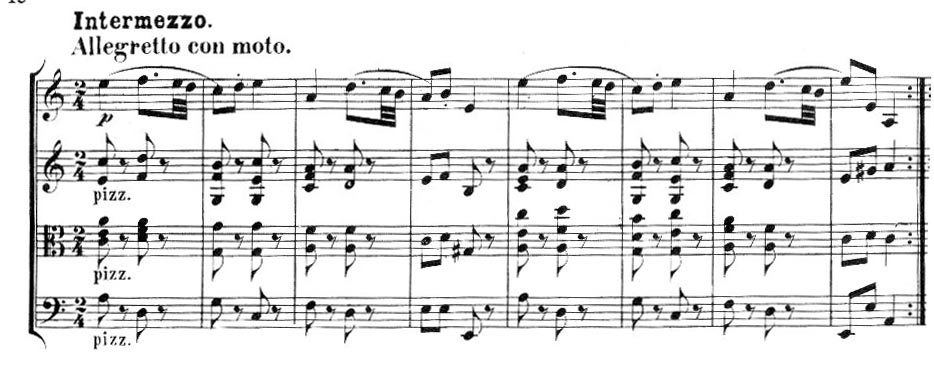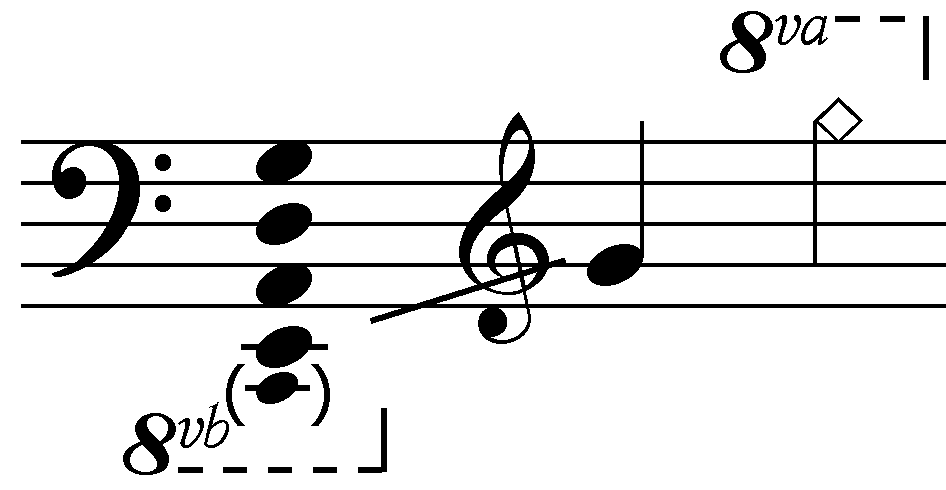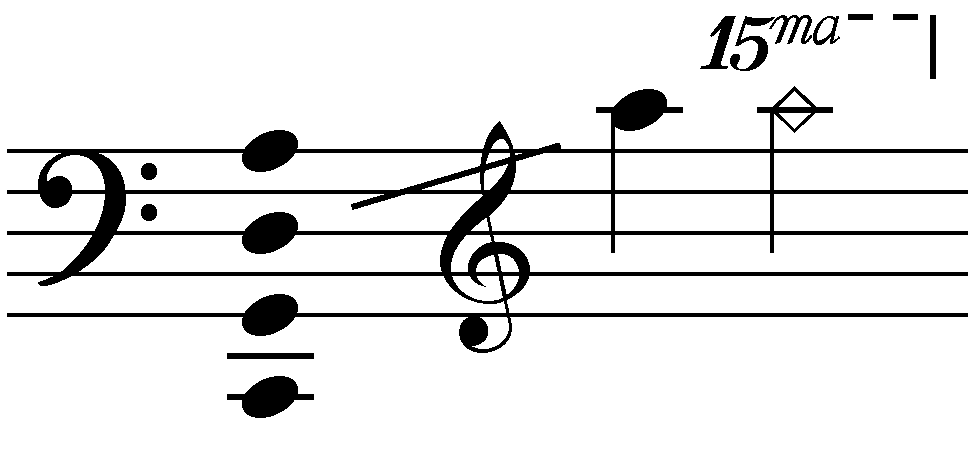|
Air On The G String
"Air on the G String", also known as "Air for G String" and "Celebrated Air", is August Wilhelmj's 1871 arrangement of the second movement of Johann Sebastian Bach's Orchestral Suite No. 3 in D major, BWV 1068. The arrangement differs from the original in that the part of the first violins is transposed down so that the entire piece can be played on just the violin's lowest string (the G string). In performance, that part is generally played by a single violin (instead of by the first violins as a group). Bach's original Bach's third Orchestral Suite in D major, composed in the first half of the 18th century, has an " Air" as second movement, following its French overture opening movement. The suite is composed for three trumpets, timpani, two oboes, strings (two violin parts and a viola part), and basso continuo. In the second movement of the suite however only the strings and the continuo play. This is the only movement of the suite where all other instruments are silent ... [...More Info...] [...Related Items...] OR: [Wikipedia] [Google] [Baidu] |
August Wilhelmj
__NOTOC__ August Emil Daniel Ferdinand Wilhelmj ( ; 21 September 184522 January 1908) was a German violinist and teacher. Wilhelmj was born in Usingen and was considered a child prodigy; when Henriette Sontag heard him in 1852 at seven years old, she said, "You will be the German Paganini". In 1861, Franz Liszt heard him and sent him to Ferdinand David with a letter containing the words "Let me present you the future Paganini!". His teachers included: Ferdinand David, for the violin, Moritz Hauptmann, for music theory and composition, and Joachim Raff for composition. A personal friend of Wagner, he led the violins at the ''première'' of '' Der Ring des Nibelungen'' in Bayreuth in 1876. He visited Australia in 1881, playing in the old Freemasons' Hall, but though appreciated by those who attended his concerts, their number was not sufficient to make the tour a financial success. It was not until introduced to London audiences by Jenny Lind in 1886 that Wilhelmj became a ... [...More Info...] [...Related Items...] OR: [Wikipedia] [Google] [Baidu] |
Part (music)
A part (or voice) generally refers to a single strand or melody or harmony of music within a larger ensemble or a polyphonic musical composition. There are several senses in which the word is often used: * the physical copy of printed or written sheet music given to any individual instrument or voice (as opposed to the full score which shows all parts in the same document). A musician's part usually does not contain instructions for the other players in the ensemble, only instructions for that individual. * the music played by any group of musicians who all perform in unison for a given piece; in a symphony orchestra, a dozen or more cello players may all play "the same part" even if they each have their own physical copy of the music. This sense of "part" does not require a written copy of the music; a bass player in a rock band "plays the bass part" even if there is no written version of the song. * any individual melody that can be abstracted as continuous and independent fr ... [...More Info...] [...Related Items...] OR: [Wikipedia] [Google] [Baidu] |
Double Bass
The double bass (), also known simply as the bass () (or #Terminology, by other names), is the largest and lowest-pitched Bow (music), bowed (or plucked) string instrument in the modern orchestra, symphony orchestra (excluding unorthodox additions such as the octobass). Similar in structure to the cello, it has four, although occasionally five, strings. The bass is a standard member of the orchestra's string section, along with violins, viola, and cello, ''The Orchestra: A User's Manual'' , Andrew Hugill with the Philharmonia Orchestra as well as the concert band, and is featured in Double bass concerto, concertos, solo, and chamber music in European classical music, Western classical music.Alfred Planyavsky [...More Info...] [...Related Items...] OR: [Wikipedia] [Google] [Baidu] |
Cello
The cello ( ; plural ''celli'' or ''cellos'') or violoncello ( ; ) is a Bow (music), bowed (sometimes pizzicato, plucked and occasionally col legno, hit) string instrument of the violin family. Its four strings are usually intonation (music), tuned in perfect fifths: from low to high, scientific pitch notation, C2, G2, D3 and A3. The viola's four strings are each an octave higher. Music for the cello is generally written in the bass clef, with tenor clef, and treble clef used for higher-range passages. Played by a ''List of cellists, cellist'' or ''violoncellist'', it enjoys a large solo repertoire Cello sonata, with and List of solo cello pieces, without accompaniment, as well as numerous cello concerto, concerti. As a solo instrument, the cello uses its whole range, from bassline, bass to soprano, and in chamber music such as string quartets and the orchestra's string section, it often plays the bass part, where it may be reinforced an octave lower by the double basses. Figure ... [...More Info...] [...Related Items...] OR: [Wikipedia] [Google] [Baidu] |
Con Sordino
A mute is a device attached to a musical instrument which changes the instrument's tone quality (timbre) or lowers its volume. Mutes are commonly used on string and brass instruments, especially the trumpet and trombone, and are occasionally used on woodwinds. Their effect is mostly intended for artistic use, but they can also allow players to practice discreetly. Muting can also be done by hand, as in the case of palm muting a guitar or grasping a triangle to dampen its sound. Mutes on brass instruments are typically inserted into the flared end of the instrument (bell). They can also be held in front of or clipped onto the bell. Of brass mutes, the "straight mute" is the most common and is frequently used in classical and jazz music, but a wide variety are available. On string instruments of the violin family, mutes are usually attached to the bridge, the piece of wood that supports the strings. Palm muting a guitar involves placing the side of the hand across the ... [...More Info...] [...Related Items...] OR: [Wikipedia] [Google] [Baidu] |
C Major
C major (or the key of C) is a major scale based on C, consisting of the pitches C, D, E, F, G, A, and B. C major is one of the most common keys used in music. Its key signature has no flats or sharps. Its relative minor is A minor and its parallel minor is C minor. The C major scale is: : On the piano, the C major scale can be played by playing only the white keys starting on C. Compositions Twenty of Joseph Haydn's 106 symphonies are in C major, making it his second most-used key, second to D major. Of the 134 symphonies mistakenly attributed to Haydn that H. C. Robbins Landon lists in his catalog, 33 are in C major, more than any other key. Before the invention of the valves, Haydn did not write trumpet and timpani parts in his symphonies, except those in C major. Landon writes that it wasn't "until 1774 that Haydn uses trumpets and timpani in a key other than C major... and then only sparingly." Most of Haydn's symphonies in C major are labelled "festive ... [...More Info...] [...Related Items...] OR: [Wikipedia] [Google] [Baidu] |
Key (music)
In music theory, the key of a piece is the group of pitches, or scale (music), scale, that forms the basis of a musical composition in classical music, classical, Western art, and Western pop music. The group features a ''tonic (music), tonic Musical note, note'' and its corresponding ''chord (music), chords'', also called a ''tonic'' or ''tonic chord'', which provides a subjective sense of arrival and rest, and also has a unique relationship to the other pitches of the same group, their corresponding chords, and pitches and chords outside the group. Notes and chords other than the tonic in a piece create varying degrees of tension, resolution (music), resolved when the tonic note or chord returns. The key may be in the major and minor, major or minor mode, though musicians assume major when this is not specified, e.g., "This piece is in C" implies that the key of the song is C major. Popular music, Popular songs are usually in a key, and so is classical music during the commo ... [...More Info...] [...Related Items...] OR: [Wikipedia] [Google] [Baidu] |
Piano
The piano is a stringed keyboard instrument in which the strings are struck by wooden hammers that are coated with a softer material (modern hammers are covered with dense wool felt; some early pianos used leather). It is played using a musical keyboard, keyboard, which is a row of keys (small levers) that the performer presses down or strikes with the fingers and thumbs of both hands to cause the hammers to strike the strings. It was invented in Italy by Bartolomeo Cristofori around the year 1700. Description The word "piano" is a shortened form of ''pianoforte'', the Italian term for the early 1700s versions of the instrument, which in turn derives from ''clavicembalo col piano e forte'' (key cimbalom with quiet and loud)Pollens (1995, 238) and ''fortepiano''. The Italian musical terms ''piano'' and ''forte'' indicate "soft" and "loud" respectively, in this context referring to the variations in volume (i.e., loudness) produced in response to a pianist's touch or pressure on ... [...More Info...] [...Related Items...] OR: [Wikipedia] [Google] [Baidu] |
Naxos Records
Naxos comprises numerous companies, divisions, imprints, and labels specializing in classical music but also audiobooks and other genres. The premier label is Naxos Records which focuses on classical music. Naxos Musical Group encompasses about 17 labels including Naxos Records, Naxos Audiobooks, and Naxos Books (ebooks). There are about an additional 50 labels that are independent of the Naxos Musical Group with a wide range of offerings. The company was founded in 1987 by Klaus Heymann, a German-born resident of Hong Kong. Naxos Records Naxos Records is a record label specializing in classical music. The company was known for its budget pricing of discs, with simpler artwork and design than most other labels. In the 1980s, Naxos primarily recorded central and eastern European symphony orchestras, often with lesser-known conductors, as well as upcoming and unknown musicians, to minimize recording costs and maintain its budget prices. In more recent years, Naxos has taken a ... [...More Info...] [...Related Items...] OR: [Wikipedia] [Google] [Baidu] |
Oliver Von Dohnányi
Oliver von Dohnányi (born 2 March 1955) is a Slovak conductor based in Prague, Czech Republic. He is currently serving as the music director of the Ural Opera House in Yekaterinburg, Russia. Dohnányi was born in Trenčín, Czechoslovakia (now in Slovakia) and studied violin, composition and conducting at the Prague Academy for Music under Václav Neumann and the University of Music and Performing Arts in Vienna under Otmar Suitner. He made his conducting debut in 1979 with the Slovak Radio Symphony Orchestra in Bratislava.Slovak National TheatreOliver Dohnányi/ref> Previously, Dohnányi served as the music director of the Czech National Theatre in Prague, Intendent/Artistic Director of the Opera of the Slovak National Theatre in Bratislava, Intendent/Artistic Director of the Opera of the Moravian-Silesian National Theatre in Ostrava, and principal conductor of the Slovak Sinfonietta. In 2018, Dohnányi received the biggest Russian theatrical award, The Golden Mas ... [...More Info...] [...Related Items...] OR: [Wikipedia] [Google] [Baidu] |
Capella Istropolitana
The Cappella Istropolitana is a Slovak chamber orchestra based in Bratislava, Slovakia. Its name is derived from the Greek name for Bratislava, ''Istropolis'' (city on the Danube). The orchestra was formed in 1983, and in 1991 the Bratislava City council appointed the orchestra as the ''Chamber Orchestra of the City of Bratislava''. The current conductor is Christian Brembeck Christian Brembeck (born 1960 in Munich) is a German conductor, organist and harpsichordist. He studied organ, piano and conducting at the Hochschule für Musik und Theater München in Munich, and was awarded the Organ Prize of the City of Würzbu .... References External links Naxos.com Profile Slovak orchestras [...More Info...] [...Related Items...] OR: [Wikipedia] [Google] [Baidu] |
Takako Nishizaki
Takako Nishizaki BBS (born 14 April 1944) is a Japanese violinist. She was the first student to complete the Suzuki Method course, at age nine. Biography Nishizaki went to the United States from Japan in 1962. She first studied with Broadus Erle at Yale University, and later with Joseph Fuchs at Juilliard. Takako Nishizaki profile naxos.com; accessed 9 March 2015. In 1964, she was a runner-up in the Leventritt Competition, in which won first prize. In 1966, she was awarded Juilliard's Fritz Kreisler Scholarship. In 1969, she won first prize in the Juilliard Concerto Competition perfor ... [...More Info...] [...Related Items...] OR: [Wikipedia] [Google] [Baidu] |





